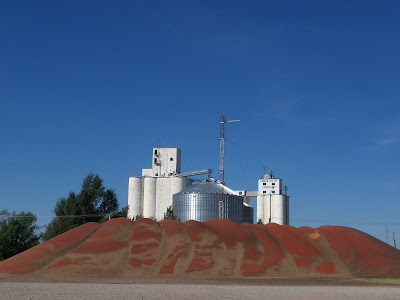 Rome wasn't built in a day. But our milo harvest was. Well, it actually took a little longer than that, but not much.
Rome wasn't built in a day. But our milo harvest was. Well, it actually took a little longer than that, but not much.Milo harvest never has the urgency of wheat harvest around here, since wheat is our primary crop and the majority of our farm's acres are planted to it. Still, there's usually a kind of positive energy surrounding a harvest season. It's the culmination of a journey that began with seeds planted at the end of May. Harvest is usually Randy's favorite time of the year.
 But it's a little different with the Drought of 2011 (Yes, I meant to put Drought in capital letters.) Randy's attitude was more, "Let's get this over with."
But it's a little different with the Drought of 2011 (Yes, I meant to put Drought in capital letters.) Randy's attitude was more, "Let's get this over with."We had 270 acres planted to milo. He cut 85 acres of it in an hour. Typically, it would take 8-10 hours to harvest a field that size. However, that field yielded a whopping 1/2 bushel per acre. The overall yield average for our 2011 crop was 6.74 bushels per acre.
 One 17-acre field brought in 21 bushels an acre. That was like a jackpot when compared to the day before. But an average yield for milo would be in the neighborhood of 65 bushels per acre. (That can have your emotions dipping back down like a roller coaster.)
One 17-acre field brought in 21 bushels an acre. That was like a jackpot when compared to the day before. But an average yield for milo would be in the neighborhood of 65 bushels per acre. (That can have your emotions dipping back down like a roller coaster.)Thankfully, we have insurance to partially cover the poor harvest. But we still had to invest some time and some diesel to harvest the milo that was in the fields.
Milo harvest required only one meal to the field. That's another indicator of a less-than-ideal harvest from this farm wife's perspective.
So we continue to pray for rain. Heck, I'd even take a wet snow right about now.
(The photo at the top of the post was taken in the field that made 21 bushels/acre yield. I'm pretty confident there won't be any piles of unbinned milo sitting around the co-op this year. What a difference a year makes!)

No comments:
Post a Comment